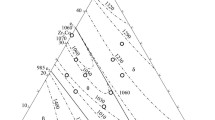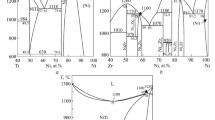Physicochemical analysis methods (metallography, X-ray diffraction, differential thermal analysis, and electron microprobe analysis) are used to first study the ZrCo–ZrNi alloys in the temperature range that includes their melting and crystallization. The phase diagram of the system is constructed. The phases based on ZrCo (crystal structure of CsCl type, maximum nickel solubility about 46 at.%) and ZrNi (crystal structure of CrB type, cobalt solubility about 2 at.%) coexist in a range from room to subsolidus temperatures. The phase diagram is of peritectic type with peritectic point coordinates 1240 ± 12°C and ~48 at.% Ni.





Similar content being viewed by others
References
D. Hossain and J. R. Harris, “A study of ZrCo and related ternary phases represented by the general formula Zr50Co50–x Ni x ,” J. Less-Common Met., 37, 35–37 (1974).
C. Lall, M. H. Lorello, and J. R. Harris, “Transformation and deformation studies of some Zr(CoNi) alloys,” Acta Metall., 26, 1631–1641 (1978).
M. Matsuda, K. Hayashi, and K. Nishida, “Microstructure and mechanical properties of Zr–Co–Ni intermetallic compound,” Mater. Sci. Forum, 638–642, 1379–1383 (2010).
E. M. Carvalho and I. R. Harris, “X-ray diffraction studies of structural changes in the system Zr50Co50–x Ni x (0 < x < 50): III,” J. Less-Common Met., 106, 143–152 (1985).
M. Matsuda, T. Nishimoto, K. Matsunaga, et al., “Deformation structure inductile B2 type Zr–Co–Ni alloys with martensitic transformation,” Mater. Sci., 46, No. 12, 4221–4227 (2011).
E. M. Carvalho and J. R. Harris, “Magnetic susceptibility studies of phase transformations in the system Zr50Co50–x Ni x (0 < x < 50): I,” J. Less-Common Met., 106, 117–128 (1985).
E. M. Carvalho and J. R. Harris, “Electrical resistivity studies of phase transformations in the system Zr50Co50–x Ni x (0 < x < 50): II,” J. Less-Common Met., 106, 129–141 (1985).
M. Matsude, K. Hayashi, and M. Nishida, “Ductility enhancement in B2-type Zr–Co–Ni alloys with martensitic transformation,” Mater. Trans., 50, No. 9, 2335–2340 (2009).
M. Matsuda, Y. Iwamoto, Y. Morizono, et al., “Enhancement of ductility in B2-type Zr–Co–Ni alloys with deformation-induced martensite and microcrack formation,” Intermetallics, 36, 45–50 (2013).
Yu. N. Koval, G. S. Firstov, J. V. Humluk, et al., “B2 Intermetallic compounds of Zr. New class of the shape memory alloys,” J. Phys. IV, 5, C8-1103–C8-1108 (1995).
Yu. N. Koval, “High-temperature shape memory effect in some alloys and compounds,” in: Mater. Sci. Forum Proc. Int. Symp. Shape Memory Materials (Kanazama, Japan, May, 1999), Kanazama, Japan (2000), Vol. 327–328, pp. 271–278.
O. L. Semenova, J.-C. Tedenac, and O. S. Fomichev, “Structural phase transformations in Zr50Co25Ni25 alloy,” Powder Metall. Met. Ceram., 55, No. 5–6, 339–346 (2016).
V. G. Ivanchenko and T. A. Kosorukova, “Phase equilibria in the ZrCo–Zr2Ni–Zr2Co partial system,” Chem. Met. Alloys, 1, 73–75 (2008).
T. A. Kosorukova, G. S. Firstov, Yu. N. Koval, et al., “Phase transformations in Zr50Co50–x Ni x intermetallics (0 < x < 50),” Dop. Akad. Nauk Ukrainy, No. 12, 114–121 (2012).
V. N. Eremenko, E. L. Semenova, L. A. Tretyachenko, and V. M. Petyukh, “Interaction of equiatomic binary compounds in ternary systems formed by group IV transition metals with nickel,” Neorg. Mater., 28, No. 6, 1173–1177 (1992).
H. T. Takeshita, S. Kondo, H. Miyamurab, et al., “Re-examination of Zr7Ni10 single-phase region,” J. Alloys Compd., 376, 268–274 (2004).
F. Delogu, “Atomistic simulation of local rearrangements in Ni50Zr50 metallic glasses subjected to compression cycles,” Intermetallics, 17, 688–695 (2009).
J. Nei, K. Young, S. O. Salley, and K. Y. S. Ng, “Effects of annealing on Zr8Ni19X2 (X = Ni, Mg, Al, Sc, V, Mn, Co, Sn, La, and Hf): structural characteristics,” J. Alloys Compd., 516, 144–152 (2012).
A. Cziráki, Zs. Kasztovsky, I. Gerõcs, et al., “Effect of cobalt on the crystallization of Ni50Zr50 amorphous alloys,” Mater. Sci. Eng. A, 133, 475–478 (1991).
E. E. Novikova, Ye. V. Tatyanin, and V. G. Kurdyumov, “Peculiarities of deformation-induced amorphization in CoZrNi alloys,” Scr. Metall. Mater., 33, No. 6, 851–855 (1995).
V. N. Eremenko, E. L. Semenova, and T. D. Shtepa, “Study of transformations in near-equiatomic Zr–Rh alloys,” in: Thermal Analysis and Phase Equilibria [in Russian], Perm (1983), pp. 109–113.
O. Guo and O. J. Kleppa, “The standard enthalpies of formation of the compounds of early transition metals with late transition metals and with noble metals as determined by Kleppa and coworkers at the University of Chikago—a review,” J. Alloys Compd., 321, 169–182 (2001).
V. G. Pushin, V. V. Kondratiev, and V. N. Khachin, “Pretransition phenomena and martensitic transformations in titanium nickelide alloys,” Izv. Vuz. Fiz., No. 5, 5–19 (1985).
V. N. Yeremenko, E. L. Semenova, L. A. Tretyachenko, and V. M. Petyukh, “Constitution of the Hf–Ni system up to 50 at.% Ni,” J. Alloys Compd., 191, 117–119 (1993).
P. Nash and C. S. Jayanth, “The Ni−Zr (nickel–zirconium) system,” Bull. Alloy Phase Diagrams, 5, No. 2, 144–148 (1984).
G. S. Firstov, J. Van Humbuck, and Yu. V. Koval, “Martensitic transformation and shape memory effect in ZrCo intermetallic compound along with Ni and Ti additions,” Metallofiz. Noveish. Tekhnol., 23, Special Issue, 21–25 (2001).
Author information
Authors and Affiliations
Corresponding author
Additional information
Translated from Poroshkovaya Metallurgiya, Vol. 56, Nos. 3–4 (514), pp. 118–130, 2017.
Rights and permissions
About this article
Cite this article
Semenova, O.L., Petyukh, V.M. & Fomichev, O.S. The Quasibinary ZrCo–ZrNi Phase Diagram. Powder Metall Met Ceram 56, 210–219 (2017). https://doi.org/10.1007/s11106-017-9888-2
Received:
Published:
Issue Date:
DOI: https://doi.org/10.1007/s11106-017-9888-2




